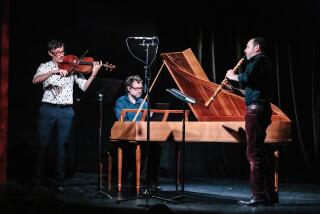La Jolla Festival Has a New York Flavor
LA JOLLA — Prospect Street, with its spectacular ocean views and beautiful young beach crowd, can seem a world away from Manhattan’s Upper West Side. There is certainly no Zabars, the popular New York delicatessen where one regularly runs into musicians or writers. Instead, a short walk up from the Contemporary Art Museum, where the La Jolla Chamber Music Society holds its SummerFest, is a coffeehouse with homey living-room furniture and a policy that admonishes against reading. (I was told that I wouldn’t be thrown out this time, because I had only one book with me.)
For three weeks this summer, however, the museum’s Sherwood Auditorium has become a kind of Lincoln Center West, now that cellist David Finckel and pianist Wu Han are the festival’s new artistic directors. Finckel is a member of the Emerson Quartet, and the couple, husband and wife, have all the right friends to entice to La Jolla.
Appearing on Tuesday’s concert were the very fine sister violinists Ani and Ida Kavafian, stalwarts of the Lincoln Center Chamber Music Society. Well-known pianist Cecile Licad was on hand; and even the popular violinist Cho-Liang Lin contributed to Schumann’s Piano Quartet. The Miami String Quartet, an exciting young group, gave the West Coast premiere of a recent work by a profound Latvian composer, Peteris Vasks. Indeed, all evening the performances were terrific, the programming unhackneyed and rewarding. Chamber music festivals often feel routine. This one doesn’t.
But outstanding as the quality has become in La Jolla, the evening didn’t feel quite right. It got off on the wrong foot with a condescending introduction by the Kavafians about Toru Takemitsu’s “Rocking Mirror Daybreak,” which the late Japanese composer wrote for them in 1983. Hardly an exotic on the West Coast, Takemitsu had close ties to La Jolla through UC San Diego, where Asian music has a strong tradition.
Indeed, this SummerFest is blind to anything local, be it La Jolla’s wide range of composers (from Ravi Shankar to Brian Ferneyhough) or the museum’s provocative show “Double Trouble,” which explores the influence of Marcel Duchamp on modern art, an influence that also had crucial implications on our coast’s most original music.
And even reaching in the other direction, to Eastern Europe, the cellist of the Miami Quartet, Keith Robinson, happily confessed that the ensemble had never heard of Vasks, despite his large cult following, until the ensemble’s record company asked it to record the composer’s three quartets. Yet this turned out to be an unusually successful performance.
Vasks is a doomsday prophet; hope in his music is usually dashed, as it is in the Third Quartet, written in 1994, in which liturgical and folk Christmas music painfully clash. The Miami Quartet played with a kind of straight-forward vigor that didn’t hide the mysterious and spiritual nature of the music or the power of its explosions, but also didn’t browbeat the audience as many Eastern European performances of Vasks tend to do.
The Kavafians played the Takemitsu also more forthrightly than his delicate music usually can withstand, but it too turned out to be a beautiful performance. The sisters, though, did seem to feel the need for grandstanding by including a flashy romantic showpiece, Moritz Moszkowki’s Suite in G Minor for two violins and piano, which followed and somewhat undid the Vasks.
Licad did not glisten in the Schumann piano quartet as she might have, but Lin, violist Toby Hoffman and cellist Alban Gerhardt were each powerful, rich, exciting. A bonus was a humorous five-minute work by Michael Finckel, “The Red Cow Is Dead,” for four mooing cellos and a speaker, New York radio personality Bernard Sherman, imported to read the E.B. White text.
Not to beat a dead cow, but again the West does this sort of thing much better, namely Utah composer Phillip Kent Bimstein’s hilarious 1990 “Garland Hirschi’s Cows.” But the Finckels apparently like to stay close to home; the composer is the cellist’s cousin. Maybe next year they could bring some H&H; bagels along as well.
More to Read
The biggest entertainment stories
Get our big stories about Hollywood, film, television, music, arts, culture and more right in your inbox as soon as they publish.
You may occasionally receive promotional content from the Los Angeles Times.











